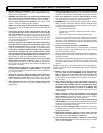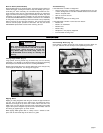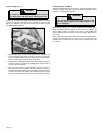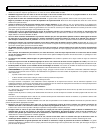
page 8
Causes and Operator Prevention of KICKBACK:
KICKBACK is a sudden reaction to a pinched, bound or misaligned saw
blade, causing an uncontrolled saw to lift up and out of the workpiece
toward the operator.
When the blade is pinched or bound tightly by the kerf, or cutting slot,
closing down, the blade stalls and the motor reaction drives the unit
rapidly back toward the operator.
If the blade becomes twisted or misaligned in the cut, the teeth at the
back edge of the blade can dig into the top surface of the wood causing
the blade to climb out of the kerf and jump back toward operator.
KICKBACK is the result of tool misuse and/or incorrect operating pro-
cedures or conditions and can be avoided by taking proper precautions
as given below:
1. Maintain a firm grip with both hands on the saw and posi-
tion your body and arm to allow you to resist KICKBACK
forces. KICKBACK forces can be controlled by the operator, if
proper precautions are taken.
2. When blade is binding, or when interrupting a cut for any
reason, release the trigger and hold the saw motionless in
the material until the blade comes to a complete stop. Never
attempt to remove the saw from the work or pull the saw
backward while the blade is in motion or KICKBACK may
occur. Investigate and take corrective actions to eliminate the cause
of blade binding.
3. When restarting a saw in the workpiece, center the saw
blade in the kerf, or cut, and check that saw teeth are not
engaged into the material. If saw blade is binding, it may walk up
or KICKBACK from the workpiece as the saw is restarted.
4. Support large panels to minimize the risk of blade pinching
and KICKBACK. Large panels tend to sag under their own weight.
Supports must be placed under the panel on both sides, near the line
of cut and near the edge of the panel.
5. Do not use dull or damaged blades. Unsharpened or improperly
set blades produce narrow kerf causing excessive friction, blade
binding and KICKBACK.
6. Blade depth and bevel adjusting locking levers must be
tight and secure before making cut. If blade adjustment shifts
while cutting, it may cause binding and KICKBACK.
7. Use extra caution when making a “Pocket Cut” into existing
walls or other blind areas. The protruding blade may cut objects
that can cause KICKBACK.
General Operation (Fig. 8)
Always clamp the workpiece securely on a saw horse or bench. See
“Applications” for the correct way to support your work in different
situations.
1. Draw a cutting line. Place the front of the shoe on the edge of the
workpiece without making blade contact. Hold the switch handle
with one hand and the depth/bevel adjusting knob (depending on
model) with the other (Fig. 8). When using 10-1/4" saws, hold the
switch handle with one hand and the front handle with the other.
2. Line up the line sight with your cutting line. Position your arms and
body to resist KICKBACK. Pull the trigger, allowing the motor to
reach full speed before beginning to cut.
3. While cutting, keep the shoe flat against the workpiece and maintain
a firm grip. Do not force the saw through the work. Forcing a saw
can cause KICKBACK.
4. If making a partial cut, restarting in mid-cut or correcting direction,
allow the blade to come to a complete stop. To resume cutting,
center the blade in the kerf, back the saw away from cutting edge a
few inches, pull the trigger and re-enter the cut slowly.
5. If the saw binds and stalls, maintain a firm grip and release the
trigger immediately.
6. After finishing a cut, be sure the lower guard closes and the blade
comes to a complete stop before setting the saw down.
OPERATION
WARNING!
To reduce the risk of injury, wear safety goggles
or glasses with side shields. Unplug the tool be-
fore changing accessories or making adjust-
ments.
Fig. 8
8. Set the depth of cut for no more than 1/8" to 1/4" greater
than the thickness of the stock. The less blade exposed, the
less chance of binding and KICKBACK. Before cutting, be sure depth
and bevel adjustments are tight.
9. Be cautious of pitchy, knotty, wet or warped stock. These are
most likely to create pinching conditions and possible KICKBACK. Do
not rip warped lumber. Avoid cutting nails.
10. Use a rip fence or edge guide when ripping. Guides improve
control and reduce blade binding.
11. Stay alert. Any distraction can cause twisting or binding. Repetitive
cuts may lull the user into careless movements.


















